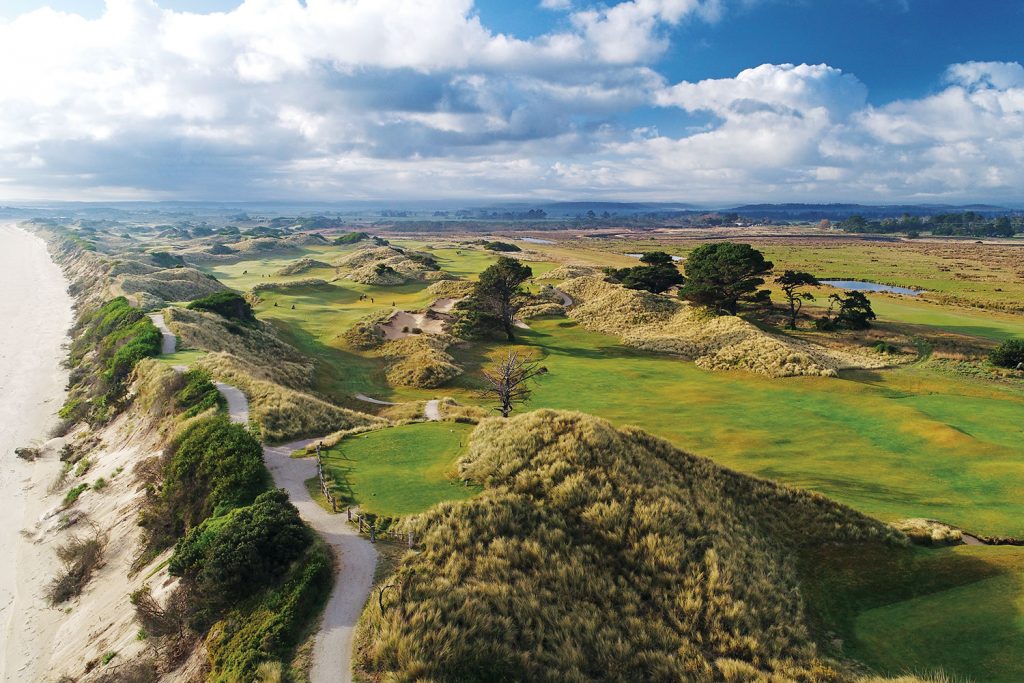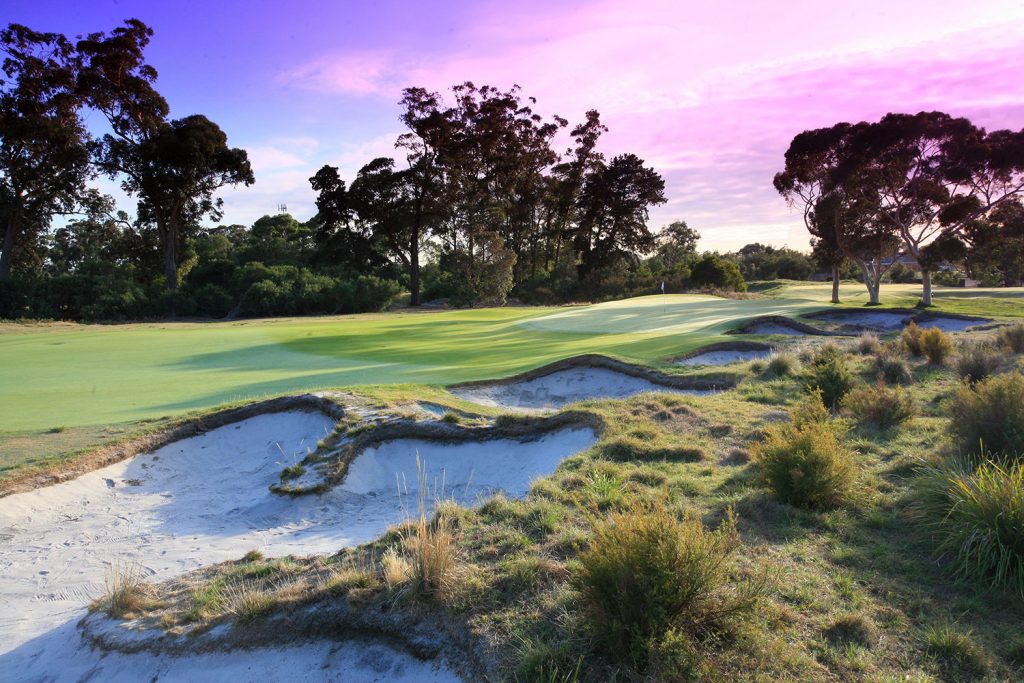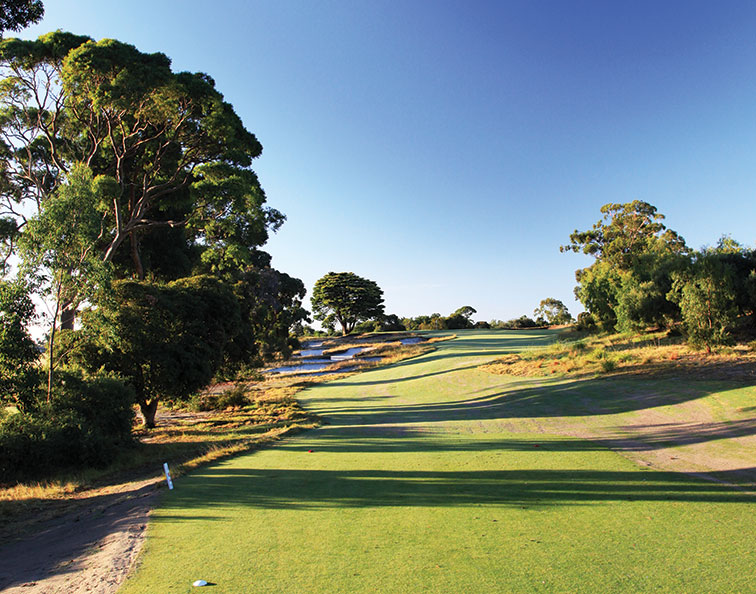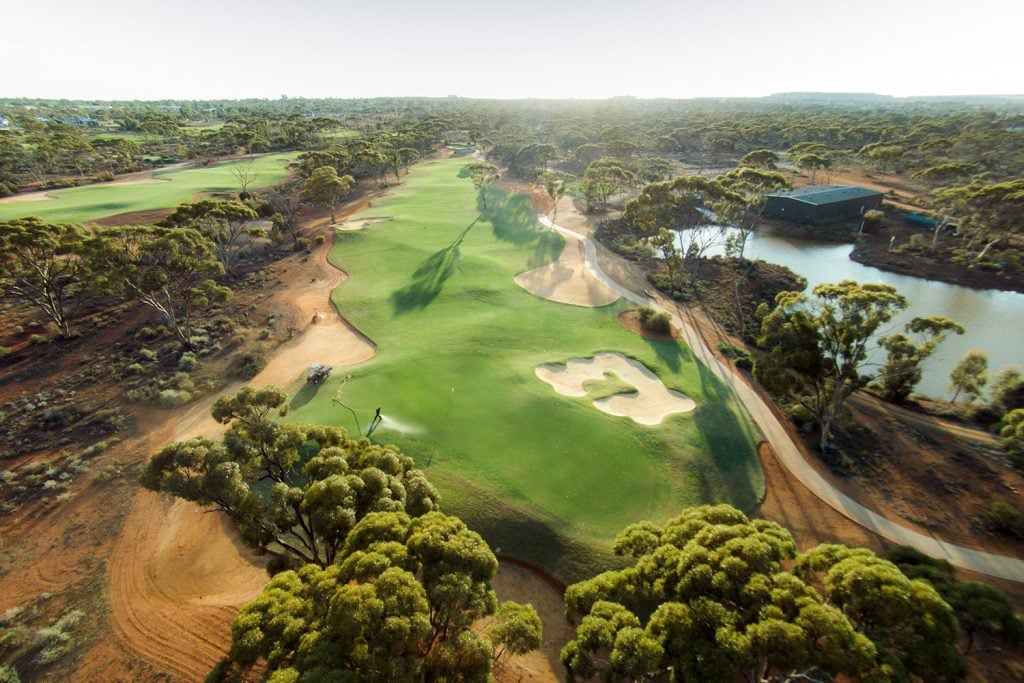IT’S IRONIC that one of the key features elevating golf in a country half the world away is just how easily accessible its courses are for the travelling golfer.
Welcome to Australia, the land Down Under, where the hard work is getting there and the hardest part is leaving. But don’t let the long haul (23-hour flight from London to Sydney; 15 hours from Los Angeles; 14 hours from Dubai; 8 hours from Singapore) deter you. You’ll need adequate research time to plan your golf experience upon arrival. There are numerous World Top-50 layouts waving tee-time sheets with your name on them, all at unbeatable prices.
Case in point, you can walk onto the world’s 11th best course outside America – Barnbougle Dunes – for little more than a box of premium golf balls. An equivalent course – or much less – elsewhere around the globe would command green fees in the vicinity of $500. Not this place.
“Australian golfers are much more price-sensitive than US golfers,” says world-renowned course architect Tom Doak, co-designer of the world’s No.11-ranked course Barnbougle Dunes in Tasmania. “Barnbougle, for how good it is, they charge somewhere between half and a third of what they’d be charging in America. But they firmly believe if they tried to charge a lot more then nobody would come.”
Whether the price point is a tip of the cap to golf’s origins or a reflection of the Australian dollar, either way, visiting golfers are the real winner, says former Golf Channel host and Australian tour player Annabel Rolley.
“Although Australia doesn’t have a great number of public golf courses compared to other nations, gaining access onto private clubs is both attainable and affordable,” says Rolley.
“There are many different scenarios that play out depending on where you play golf, but the major contributing factor to the cost of golf anywhere in the world is basic economics – supply and demand. In Australia, the ratio plays into the golfer’s hands.”
Nine of those private courses Rolley refers to were recently ranked in Golf Digest’s World’s Top 50 Courses. It’s a staggering result, yet one that shouldn’t be all that surprising given Australia’s storied history in golf, particularly in golf-course design. Architectural roots first sewn in the 1920s by local visionaries like Alex Russell (designer of Royal Melbourne East Course, Yarra Yarra and Lake Karrinyup) have been ably matched by the likes of late five-times British Open champion Peter Thomson (Hamilton Island, Moonah Links), Michael Clayton (Barnbougle Dunes), Ross Watson (Magenta Shores), Greg Norman (Ellerston) and most recently, golf course critic-turned designer Darius Oliver (Cape Wickham).
What redesign projects local designers can’t get their hands on are quickly being snapped up by the world’s best, most notably Doak, who has several projects on the go in Australia in 2018, including Sydney’s Concord Golf Club, Melbourne’s famed Yarra Yarra and The National Golf Club’s Ocean course, originally designed by Thomson down on Victoria’s iconic Mornington Peninsula.
“I’m well aware I’ve taken some work away from Australian-based designers,” admits Doak. “This is such an odd business. I’ve got some good friends that are architects down here and they would all love to be consulting on Royal Melbourne, Yarra Yarra and some of the clubs we’re working with. At the same time, Mike Clayton and Geoff Ogilvy are trying to win jobs in the States, too. So I don’t think there’s any real animosity there. The odd thing is, it’s always been that way. Alister MacKenzie had the advantage of also being the ‘cool guy from outside’ and there was cachet to that. That’s why Royal Melbourne hired him and that’s why everybody else said, ‘Oh, if he’s the best, let’s get him too.’ I’m kind of going through the same thing now.”
So what is it about Australia that has course designers the world over bidding for everything?
“Architects like America’s Doak have embraced the features of links golf around Australia,” says Steve Keipert, Top 100 Courses editor for Australian Golf Digest. “Peter Thomson carved a playing career unmatched on the world’s finest links. Mike Clayton built his reputation on remodelling courses with strategic design associated with links golf … the appeal of links golf has dovetailed into a worldwide fascination with golf by the seaside thanks largely to courses like Tasmania’s ‘Big Four’ – Barnbougle Dunes, Lost Farm, Cape Wickham and King Island newcomer Ocean Dunes. All four are spectacular-looking courses where it seems an objective was to leave the impression of terrain untouched, unblemished, as if Mother Nature had designed it herself.”
Adds Doak: “In some ways, I think Australia is light years ahead of the rest of the world because its courses are dealing with (architectural) issues that other countries like America haven’t got a handle on at all yet,” referencing water management as a key behind the world-class conditioning found on Australian courses.
And that’s what you’re in for during your trip to Australia: access to world-class golf courses, in world-class condition at a price point that the envy of the Northern Hemisphere.
SNAPSHOT: AUSTRALIAN COURSES IN THE 2018 GOLF DIGEST WORLD TOP 50
ROYAL MELBOURNE (WEST)

World Ranking: 3
Location: Black Rock, Melbourne
Course details: 6,645 yards, par 72
Rundown: Alister MacKenzie’s 1926 routing fits snuggly into the contours of the rolling sandbelt land. His greens are miniature versions of the surrounding topography. His crisp bunkering, with vertical edges, a foot or taller, chew into fairways and putting surfaces. Most holes are doglegs, so distance means nothing and angle into the pin is everything. For championships, holes 8 and 9 and 13 through 16 are skipped in favour of six from the East Course, which is ranked 28th. That “composite course” was once ranked among the best in the world by several publications.
Inside word: “Any time I’ve been to Australia, every time I’ve been anywhere near Melbourne, I’d just go out and walk the golf courses at Royal Melbourne because I love them.” – Tom Doak, golf course architect
BARNBOUGLE DUNES

World Ranking: 11
Location: Bridport, Tasmania
Course details: 6,724 yards, par 71
Rundown: A 2004 collaboration of American superstar designer Tom Doak and Australian tour-pro-turned-architect Michael Clayton, Barnbougle Dunes is a tremendous 18 in a fantastic stretch of sand dunes along Bass Strait, the sea that separates Tasmania from Melbourne. What’s most fascinating is that the back nine is completely reversed from how Doak originally routed it. So was the site so good that, once construction started, Doak and Clayton were able to find nine new green sites at the opposite ends of holes originally envisioned? Or did they create those “natural” green sites?
Inside word: “Absolutely stunning. I think that this is not only one of Australia’s best, it is one of the best courses in the world, old or new.” – Geoff Ogilvy, 2006 US Open champion
KINGSTON HEATH

World Ranking: 13
Location: Heatherton, Melbourne
Course details: 7,102 yards, par 72
Rundown: Considered an Alister MacKenzie design, but in fact Australian golf professional Des Soutar designed the course in 1925. MacKenzie made a brief visit the following year and suggested the bunkering, which was constructed by greenkeeper Mick Morcom before he built Royal Melbourne’s two courses. The bunkers are long, sinewy, shaggy, gnarly, windswept and, of course, strategically placed. Some say MacKenzie’s tee-to-green stretch of bunkers on the par-3 15th set the standard for all Sandbelt layouts.
Inside word: “An early morning or late evening stroll around Kingston Heath is one of life’s genuine golfing pleasures. There isn’t a better bunkered course in Australia, nor are there many in world golf with so few reasons for a guest to grumble or groan.” – Darius Oliver, golf course critic and co-designer of Cape Wickham Links
NEW SOUTH WALES
World Ranking: 18
Location: Le Perouse, Sydney
Course details: 6,829 yards, par 72
Rundown: On the dramatic rugged seacoast of Botany Bay near Sydney, on the spot where Captain Cook first stepped onto Australia in 1770, La Perouse is renowned for its ocean views and high winds. On his brief but productive 1926 trip, Alister MacKenzie prepared a routing for the course, but it was radically altered during a 1936 remodelling by Eric Apperly and by neglect during WWII. A succession of post-war architects has slowly re-established the integrity of the design, most recently Greg Norman.
Inside word: “I can still remember the first time I played NSW, surveying the first hole and wondering if I had put enough balls in the bag. Every view was a postcard, and every new hole encountered a thrill. That sense of excitement stays with me more than 20 years later, and is the reason why NSW GC is the greatest experience in Australian golf.” – Grant Dodd, former Australian tour pro-turned commentator.
ROYAL MELBOURNE (EAST)

World Ranking: 19
Location: Black Rock, Melbourne
Course details: 6,579 yards, par 71
Rundown: Former Australian Open champion Alex Russell and greenkeeper Mick Morcom built the West Course to plans of Alister MacKenzie, then added the East in 1931, on somewhat less inspiring land, flatter and more wooded. But the bunkering and green contours are very similar to the West. (Mackenzie had routed a nine-hole East Course that was never built. Russell incorporated a few of those holes.) A slight flaw may be that all four par 3s play in the same northerly direction. For composite tournament play, East’s holes 1-3 and 16-18 are used along with 12 of the West holes.
Inside word: “One half of the greatest golf club in the world” – Greg Norman, former world No.1 and two-time British Open champion.
CAPE WICKHAM LINKS

World Ranking: 24
Location: King Island, Tasmania
Course details: 6,725 yards, par 72
Rundown: American Mike DeVries and Australian golf writer Darius Oliver collaborated on a breathtaking site along Bass Strait, a notorious stretch of Australian seacoast that once shipwrecked many voyages. The routing on this glorious collection of holes is heart-pounding, starting along rocks and crashing surf, moving inland but not out of the wind, returning to ocean edge at the downhill 10th, pitch-shot 11th and drivable par-4 12th. It then wanders into dunes before a crescendo closing hole curving along Victoria Cove beach, which is in play at low tides.
Inside word: “It’s great fun to hit knockdown shots and bump and runs, keeping the ball down out of the wind and the letting it bounce along the turf. In a nutshell, the entire Wickham experience is Australian golf’s best-kept secret.” – Rohan Clarke, editor-in-chief of New Zealand Golf Digest
BARNBOUGLE LOST FARM

World Ranking: 26
Location: Bridport, Tasmania
Course details: 6,849 yards, par 72
Rundown: On a site just across the river from sister Barnbougle Dunes (No.11), with taller dunes but fewer of them, Lost Farm has not 18, but 20 holes, counting its two short pitch-shot bye holes. The design is dramatic and unusual, particularly the par-4 fifth, a dogleg right along the river, whose blind tee shot brings to mind the 17th at St Andrews. Instead of old black sheds, a high dune blocks view of the fairway from the tee. Billed as a Coore and Crenshaw design, schedule conflicts kept Ben Crenshaw from participating. Bill Coore used the usual C&C construction team, though.
Inside word: “Lost Farm may have the best finishing hole in the country. So many options with the long second shot. My favourite to play.” – Mike Clayton, former tour pro and co-designer of Barnbougle Dunes.
ELLERSTON

World Ranking: 31
Location: Hunter Valley, New South Wales
Course details: 7,312 yards, par 72
Rundown: No other course on the World Top 100 is so brutally honest about its intention to be a ball buster. The late media mogul Kerry Packer commissioned Greg Norman to build him the nation’s toughest course, and Norman complied. Routed on slopes and in a valley on Packer’s estate, it has water in play on half the holes. A superb aerial game is needed to clear deep bunkers and reach greens perched perilously close to the Pages Creek. After its opening, Norman said, “We had no need to consider forward tees, resort traffic or weaker hitters. We were able to create a course that a golfer of my calibre would love to play everyday.”
Inside word: “Don’t think I’ve played a course that tickles the imagination as much as Ellerston. Some of the most memorable holes in the country rest on one of the most picturesque and truly ‘Australian’ parcels of land. A bucket-list experience for those lucky enough to tread its tough fairways.” – Brad Clifton, editor-in-chief of Australian Golf Digest
VICTORIA GC

World Ranking: 45
Location: Melbourne
Course details: 6,888 yards, par 72
Rundown: Located kitty-corner across a road from Royal Melbourne, Victoria Golf Club is the home course of stars Peter Thomson and Geoff Ogilvy. It was designed originally by a couple of club founders. Alister MacKenzie made bunkering suggestions during a 1926 visit, changes later implemented by Alex Russell. Victoria has smaller greens than at other prominent Melbourne courses, and the bunkers hard against the collars make them play even tighter. Once heavily forested, consulting architect Michael Clayton is slowly removing many trees..
Inside word: “A special course and a special place, filled with members who love their club and are very welcoming to guests.” – Stephen Pitt, chief executive officer of Golf Australia
And now for something uniquely Australian…

There’s desert golf and then there’s playing a round at Kalgoorlie in Australia’s historic goldmine capital of Western Australia. Since its official opening in November 2010, Kalgoorlie Golf Course has been tested by a number of PGA events and its reputation has proudly survived with distinction.
Designed by a man who was born there 74 years ago, Graham Marsh’s “Goldfields” project is a stark reminder of how far golf in this region has progressed since 1899 when the first nine-hole layout in Kalgoorlie was opened on an old racetrack. Thanks to the City of Kalgoorlie-Boulder and the WA Government, golf in Kalgoorlie has proudly stamped its claim on the international golf scene and is an absolute must-play for visiting golfers.
“I distinctly recall my first design visit to Kalgoorlie. As I roamed the site my mind was racing; this was my opportunity to design Australia’s first genuine desert golf course,” says Marsh.
He didn’t disappoint. At first, the golfer’s visual sense tingles looking at each hole surrounded by red ochre sand and dirt. The juxtaposition of beautiful green couch fairways and vast red sand (left as natural as Marsh could afford), in addition to towering wattle and gum trees, is on the right side of overwhelming. When the aesthetic appeal settles, an appreciation of Marsh’s design sets in. Kalgoorlie stays true to the design philosophy of a desert course – only a single cut of semi-rough protects the golf ball from rolling into the natural Australian desert scrub – a place every visitor must try hitting from at least once.
While you’re there: When you’re not teeing off at Graham Marsh’s desert creation, immerse yourself in the rich Australian history of Kalgoorlie and Boulder. Both town halls were built in 1908, and depict the architectural style of the gold rush days. Boulder Town Hall boasts the renowned Philip Goatcher stage curtain, The Bay of Naples. The drop canvas is believed to be the only surviving theatre curtain by Goatcher and illustrates a Neapolitan scene, with Mt Vesuvius in the background
How to plan the perfect trip
Need more help to plan that perfect golf getaway to Australia? Look no further than Great Golf Courses of Australia. A comprehensive and centralised resource for visitors seeking access information on Australia’s leading golf courses and iconic golf tourism experiences, Great Golf Courses of Australia can tailor an experience to your interests and specific location. Go to greatgolfaustralia.com.au
For more information on a Golfing Great head to Visit Victoria.
